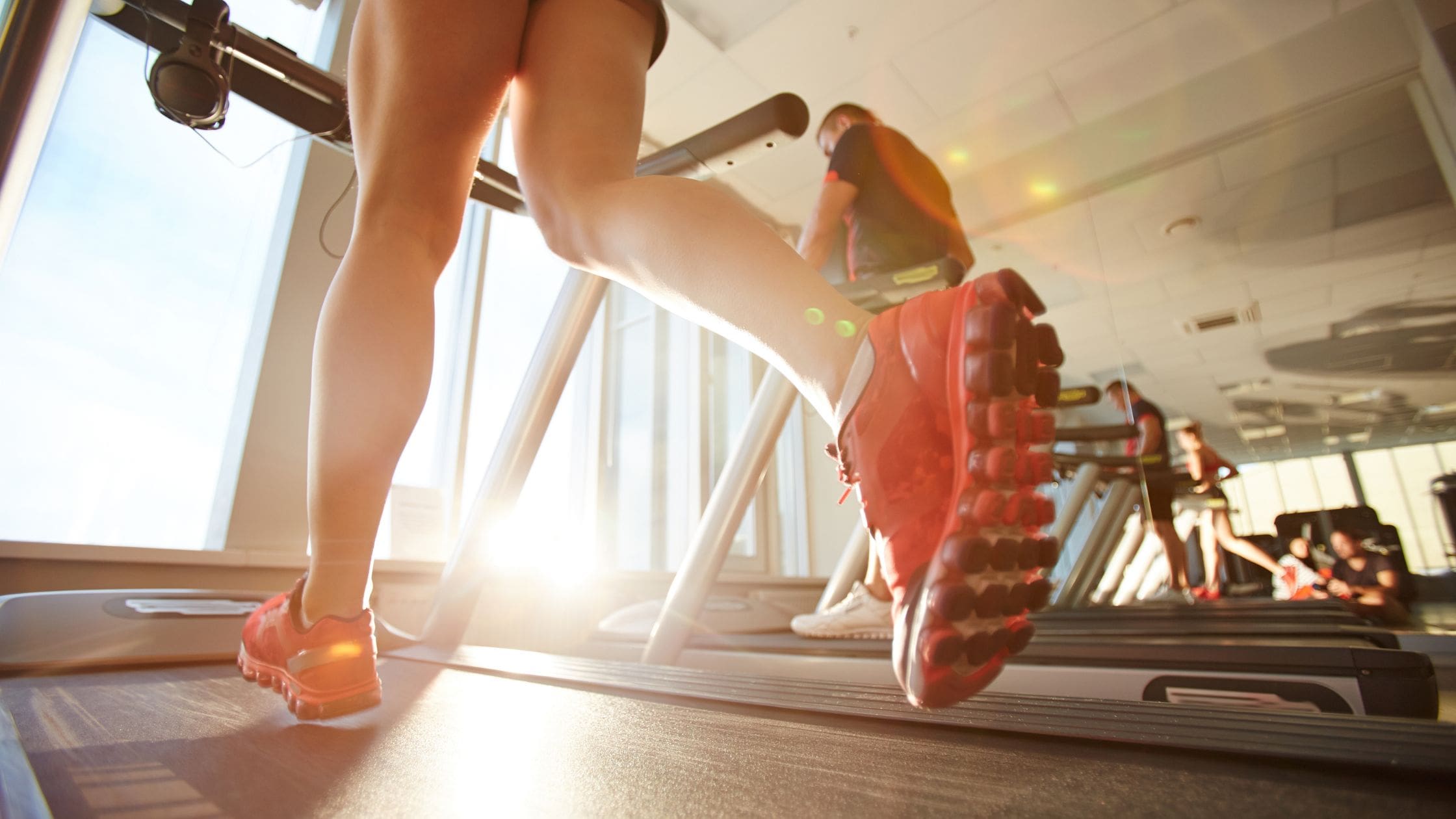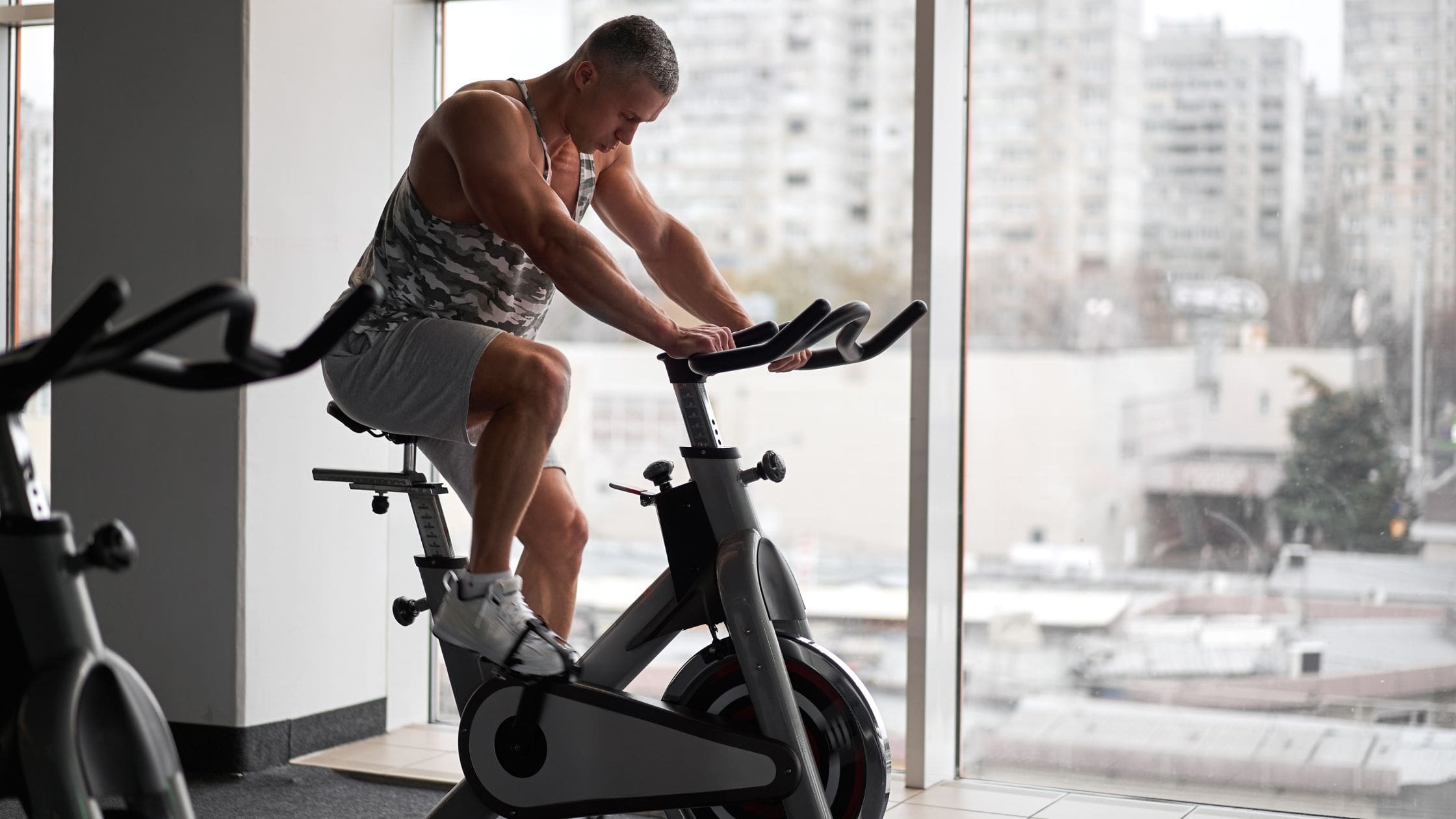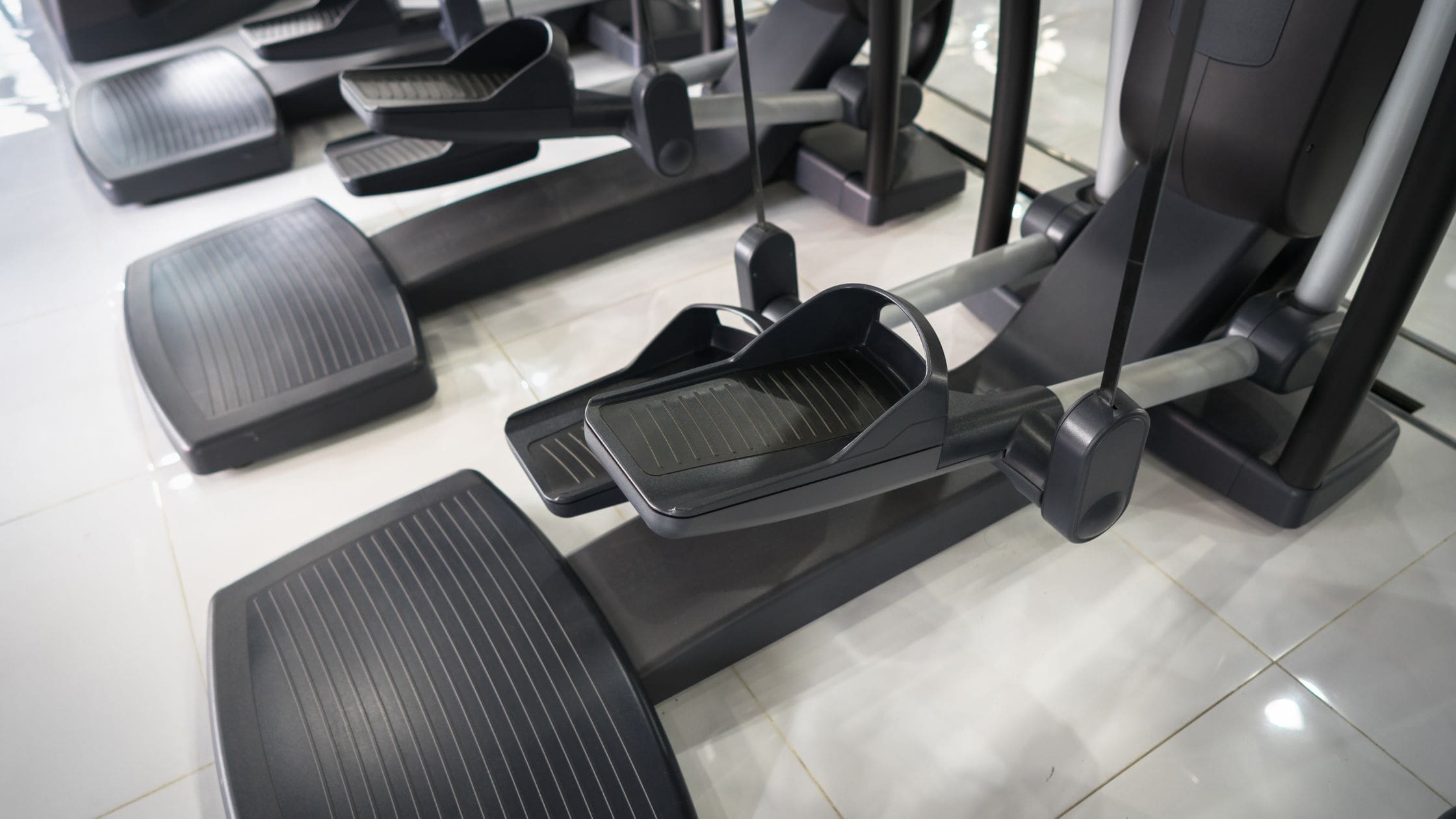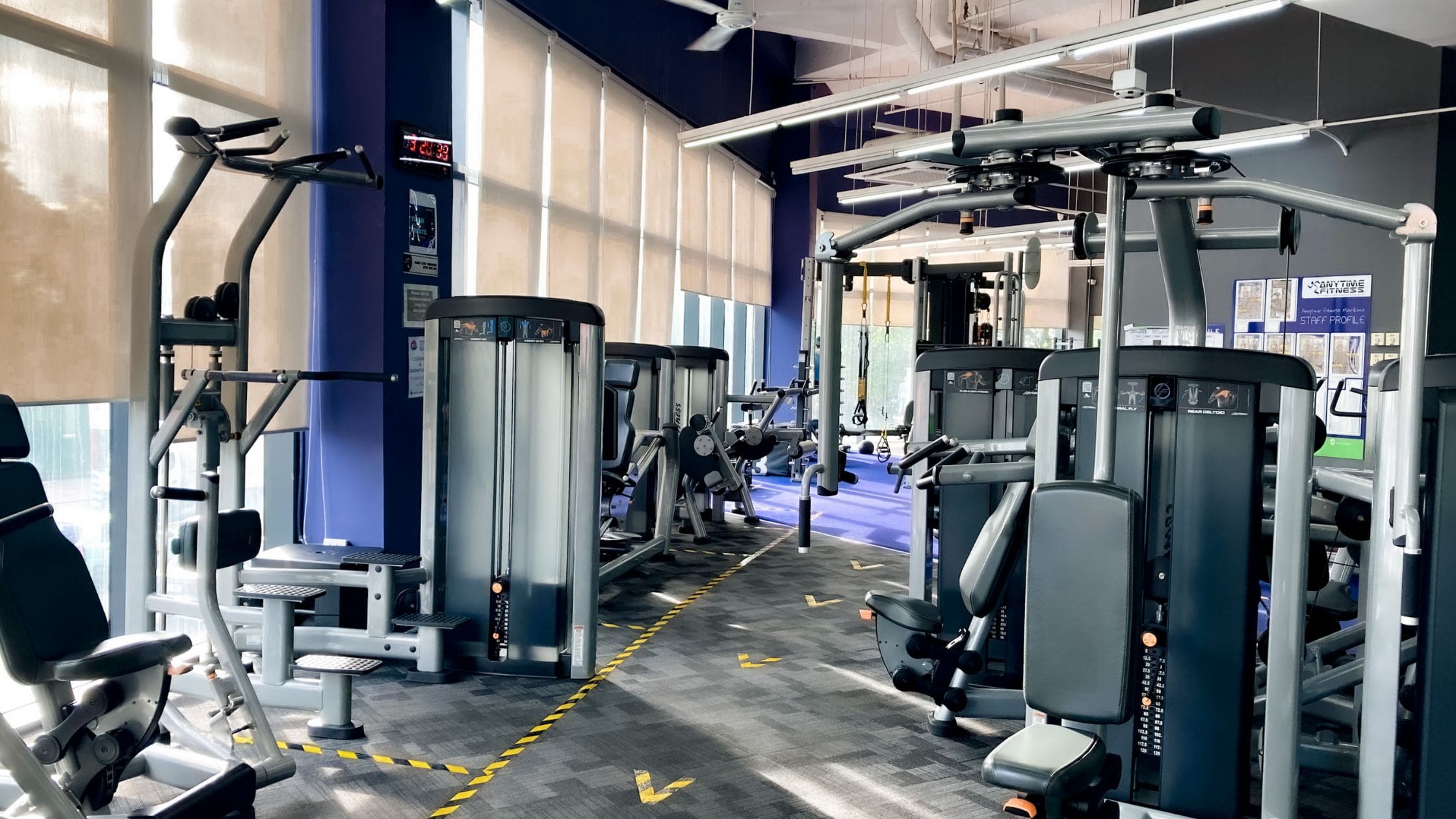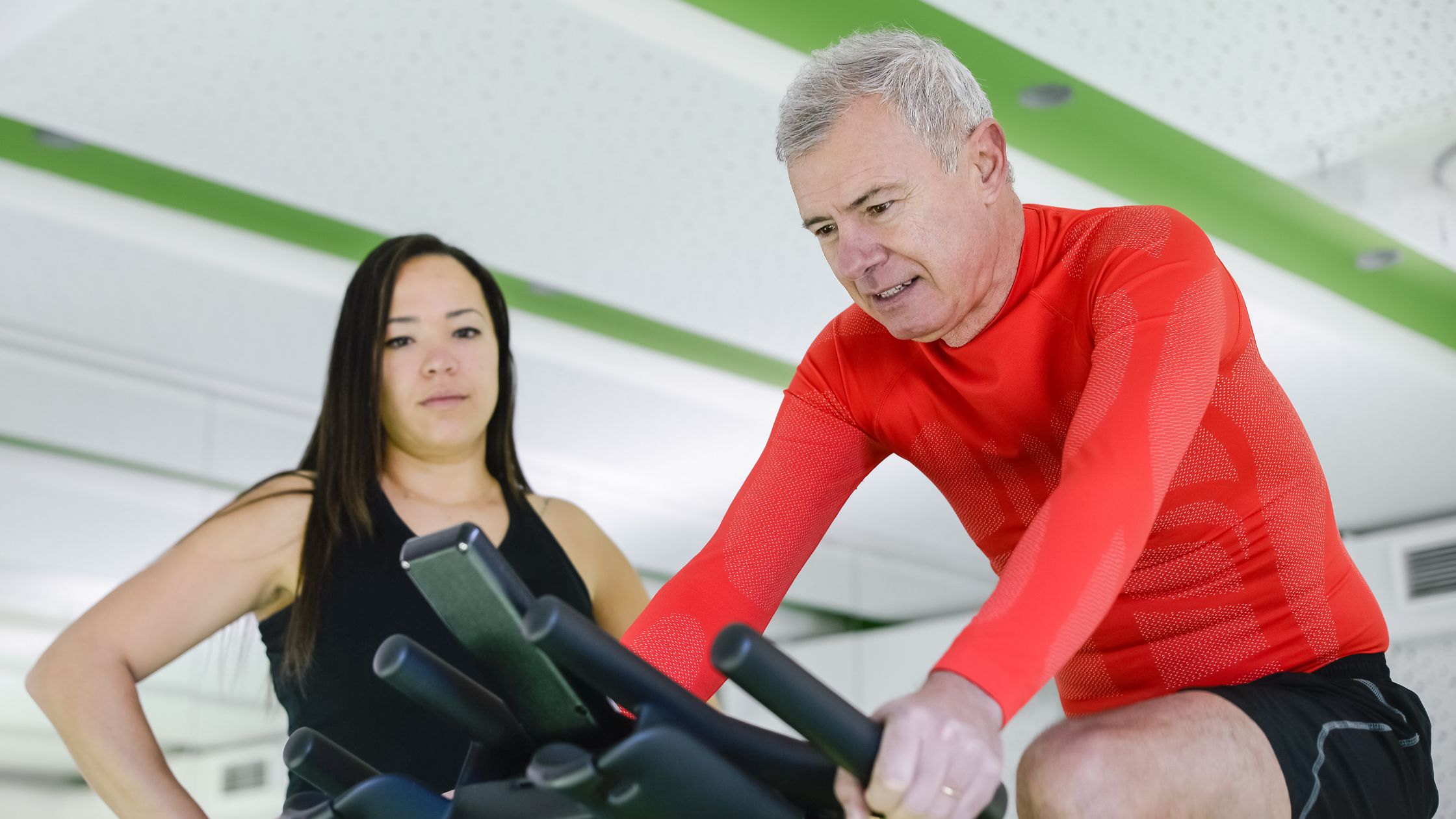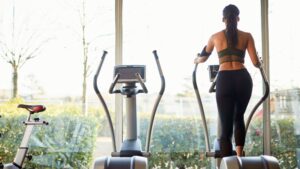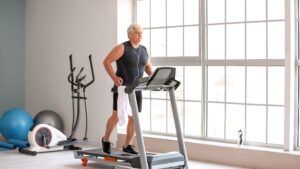Cardio equipment are machines designed to raise your heart and breathing rate through steady, rhythmic movement, helping you train your cardiovascular system, build endurance, and improve overall health.
They’re a staple in both home gyms and fitness facilities because they make cardio convenient, consistent, and trackable with metrics like speed, distance, wattage, cadence, calories, and heart rate. Studies show that regular cardio reduces the risk of heart disease, stroke, type 2 diabetes, and certain cancers, while also improving mood, sleep, and overall well-being. Even beginners can start with 20 minutes three times per week, building toward the guideline of 150 minutes of moderate activity weekly. Along the way, aerobic training improves heart efficiency, boosts good cholesterol (HDL), lowers bad cholesterol (LDL), and reduces plaque buildup in arteries.
These machines also offer adjustable intensity, low- to high-impact options, and clear progress tracking, making it easier to stay consistent than outdoor-only training. Impact can range from very low (recumbent bikes, ellipticals) to high (hard treadmill sprints). Core choices include treadmills, ellipticals, bikes (upright, spin, recumbent, air/fan), rowers, and stair climbers, with specialty options like SkiErgs, VersaClimbers, Jacob’s Ladder, and arm ergometers for more variety. When buying, whether for home or a gym, quality and durability matter as much as features like incline and resistance. Working with a trustworthy supplier ensures safety, service, and long-term value, while budget, space, and deciding between new and used machines help guide the final choice.
In this article, we’ll focus on the main types of cardio machines, their benefits, and how to choose the right one for your goals.
What is Cardio Equipment?
Cardio equipment refers to exercise machines designed to increase heart rate through continuous, rhythmic body movements that engage large muscle groups. These machines provide a structured way to perform cardio exercise indoors, allowing you to train consistently regardless of weather, terrain, or time of day. Their main role is to support cardiovascular health, endurance, and calorie expenditure while giving you full control over motion, resistance levels, and workout programs.
Most cardio machines, such as treadmills, exercise bikes, rowing machines, and ellipticals, include displays that track data like speed, distance, heart rate, calories, and watts. By adjusting resistance, incline, stroke rate, or cadence, you can tailor the workout to your fitness level and specific goals. Unlike outdoor activity, cardio equipment offers safer surfaces, repeatable intervals, and low-impact options that are especially useful for rehab or mobility issues.
For beginners, a simple cue is aiming for at least a 50% increase over resting heart rate during sessions. As you progress, you can measure intensity with workload, time, or heart rate zones. Accessibility also matters: features like seat height, stride length, pedal depth, and handle reach ensure comfort and compliance with safety regulations.
What are the Benefits of Using Cardio Equipment?
The main benefits of cardio equipment are improved heart health, calorie burn, endurance, and accessibility. These advantages go beyond fitness facilities and extend to home users, making cardio workouts practical for many fitness levels.
- Heart Health: Cardio machines strengthen the heart pump, improve circulation, and support healthier lipid profiles, including higher HDL and lower LDL levels. Consistent training can reduce plaque buildup in arteries.
- Calorie Burn: Treadmills, stair climbers, and fan bikes can produce high energy expenditure. Machines that engage both upper and lower body, such as rowing machines and air bikes, make calorie burn more efficient.
- Endurance and Stamina: Interval training and steady-state cardio workouts on equipment like a rowing ergometer or spin bike build aerobic capacity and improve lung function.
- Bone and Muscle Support: Weight-bearing machines like a treadmill or stair climber promote bone density, while bikes and ellipticals protect joints during recovery.
- Accessibility: Indoor training eliminates weather obstacles and provides progress tracking with displays and control panels. Low-impact options like a stationary bike or recumbent bike support users with joint issues.
- Well-Being: Regular cardio exercise enhances sleep quality, balances energy, and reduces stress, improving your overall workout experience.
What is the Difference Between Cardio Equipment and Other Gym Equipment?
Cardio equipment differs from strength training machines and weights in both purpose and physiological outcome. The primary function of cardio machines is to challenge the cardiovascular system through sustained aerobic exercise. They emphasize heart rate, endurance, and energy expenditure, while strength equipment focuses on muscle force production, hypertrophy, and bone density.
The energy profile also separates the two. Cardio exercise is rhythmic and continuous, often producing high calorie expenditure during each workout. In contrast, strength training uses short, high-force movements that burn fewer calories per session but increase long-term metabolism through lean mass gains.
Weight-bearing differences add another distinction. Treadmills and stair climbers promote bone health through loading, while exercise bikes and rowing machines provide joint-friendly support. Tracking progress also varies: cardio machines measure speed, cadence, watts, and heart rate, whereas resistance machines monitor load, sets, and reps.
Your choice depends on purpose. If you aim to run a race or improve endurance, machines like treadmills, rowers, and upright bikes are most effective. If your goal is maximal strength, weight machines or free weights are essential.
What are the Different Types of Cardio Machines and Equipment?
Cardio machines represent the core of most fitness facilities and home gyms because they provide structured, measurable ways to improve cardiovascular health. Each machine is designed to target heart rate, endurance, and calorie burn while accommodating different fitness levels and preferences. A treadmill supports walking and running with adjustable speed and incline, while exercise bikes and ellipticals emphasize low-impact training. Rowing machines and fan bikes combine upper and lower body movement for a full body workout. Specialized designs such as Jacob’s Ladder or ski ergometers expand the workout experience for gym goers who want variety beyond traditional cardio exercise.
What is a Treadmill?
A treadmill is a cardio machine with a moving belt that allows you to walk, jog, or run indoors under controlled conditions. It may be motorized, with a motor driving the belt, or manual, where speed is determined by your steps. The frame includes handrails, deck cushioning, an incline motor, and safety features like a tether or emergency stop. Some advanced versions use slats or a curved belt to create fluid motion powered only by body weight, providing a more natural stride.
The treadmill is one of the most studied types of cardio equipment. Research in the International Journal of Research in Exercise Physiology (2019) found that treadmills produced the highest calorie burn across intensities compared to other cardio machines. A 2021 study in the Journal of Sports Science & Medicine reported that treadmill use led to higher fat oxidation than elliptical trainers or rowing machines at similar intensity levels.
Price ranges vary by use and quality. New home treadmills typically cost $500–$3,000, while commercial-grade models found in gyms range from $2,000–$8,000+. Used models fall between $250–$1,500 for home units and $1,000–$4,500 for commercial machines.
Treadmills are best for runners, walkers, or anyone who wants efficient calorie expenditure and hill training through incline features. They are not ideal for users with active knee, back, or balance issues, who may be better suited to low-impact machines like ellipticals.
Applications include:
- 5K/10K Training: Builds endurance and prepares you for race-specific pacing.
- Incline Walking: Strengthens the lower body and simulates hiking.
- Steady-State Sessions: Supports fat oxidation and cardiovascular health.
- Interval Training: Short bursts at high intensity improve lung function and calorie burn.
- Rehab Walking: Provides a safe, controlled surface for recovery.
Tips for use:
- Start Safely: Straddle the belt before beginning, then step onto the moving surface.
- Master Controls: Learn manual speed and incline settings before using programs.
- Maintain Posture: Keep your eyes forward and avoid leaning heavily on the rails.
- Use Incline: Target back muscles and legs with uphill settings.
- Curved Models: Step higher on the curve to increase pace and drift back to slow down.
What are the Types of Treadmills?
Treadmills are not all the same, and the design you choose can change your workout experience significantly. They all have unique advantages, from the precise controls of motorized models to the natural stride mechanics of curved belts. Understanding the differences helps you pick the option that best fits your fitness goals, available space, and budget.
- Motorized: Provides precise speed and incline adjustments, making it ideal for structured workout programs. However, it usually requires more space and produces higher noise levels.
- Manual Flat Belt: A budget-friendly option where the user powers the belt. It has fewer features, limited top speeds, and a steeper learning curve.
- Slat-Belt: Built with interlinked slats that distribute impact evenly and mimic outdoor running. These treadmills are durable and smooth but come at a higher cost.
- Curved: A self-propelled design that allows unlimited speed. It responds quickly to your stride and is excellent for interval training but less comfortable for steady, easy running.
What is an Elliptical Trainer?
An elliptical trainer is a cardio machine designed to simulate walking or running while keeping your feet on pedals that follow an oval, or elliptical, path. This motion reduces impact on the joints while still providing an effective cardio workout. The machine typically includes a flywheel, drive system, resistance controls, and often moving handlebars that let you engage the upper body along with the lower body. By adjusting resistance levels and incline, you can modify intensity and target different muscle groups, including legs, glutes, and back muscles.
Ellipticals are popular in fitness facilities and home gyms because they offer fluid motion that feels natural and supports cardiovascular health without the pounding stress of running on hard surfaces. Many commercial gyms provide front, center, or rear-drive designs, with displays tracking heart rate, distance, calories, and speed.
Average prices range from $300–$2,000 for home models and $1,000–$5,000+ for commercial-grade ellipticals. Used machines usually cost $150–$900 for home and $600–$2,500 for gym-quality units. Ellipticals are best for beginners, joint-sensitive users, and runners seeking cross-training.
Applications include:
- Steady Fat-Loss Cardio: Long, consistent sessions help burn calories efficiently.
- HR-Controlled Base Work: Training within heart rate zones supports endurance and lung function.
- Active Recovery Days: Low-impact sessions maintain movement without adding strain to the knees and joints.
Tips for use:
- Stand Tall: Keep posture upright without leaning heavily on the handles.
- Start Simple: Learn legs-only rhythm before adding arm movement.
- Adjust Incline: Target glutes and hamstrings by increasing incline.
- Check Fit: Ensure stride length and step-up height match your body dimensions and ceiling clearance.
What are the Types of Ellipticals?
Elliptical machines come in several variations, and knowing the differences helps you choose the one that best fits your workout routine and mobility needs. Each type has distinct features that influence comfort, intensity, and muscle group engagement.
- Standard Elliptical: Focuses mainly on lower body exercise; compact design with simple coordination demands.
- Cross-Trainer Elliptical: Includes moving arms for upper body engagement; allows forward and backward pedaling to vary muscle emphasis.
- Recumbent Elliptical: Features a seated position with back support; combines pedaling with push-pull arm motion, ideal for users with mobility issues or those seeking long, low-impact sessions.
What Is an Exercise Bike?
An stationary exercise bike is a cardio machine that uses a seated crank-and-flywheel system with adjustable resistance to simulate cycling indoors. It includes pedals, a saddle, handlebars, and a display panel that tracks metrics like cadence, watts, calories, and heart rate. Resistance levels can be adjusted using magnetic, friction, or air technologies, giving you control over workout intensity.
The bike works by translating pedal motion into energy expenditure against the flywheel. Upright bikes mimic road-bike posture, spin bikes support aggressive positions for interval workouts, recumbent bikes feature reclined seating with back support, and fan bikes use air resistance and moving arms to engage the upper and lower body.
A 2019 study by the American College of Sports Medicine confirmed that regular cycling improves aerobic capacity and supports heart health in adults across different fitness levels.
New models typically cost $500–$2,500 for upright or spin bikes, $1,000–$4,000 for recumbent bikes, and $500–$2,000 for air resistance designs. Used options range from $100–$800 for home models and $300–$1,500 for commercial-quality units.
Exercise bikes are best for users seeking joint-friendly cardio exercise, interval training, or rehabilitation after lower body injury. They may not suit individuals with anterior knee pain, in which case an elliptical machine may provide better comfort. Impact level ranges from very low in seated recumbent use to low-medium for spin bike workouts performed out of the saddle.
Applications include:
- Tempo Rides: Build steady endurance with consistent resistance.
- Watts-Based Intervals: Improve power output and cardiovascular health with structured intervals.
- Low-Impact Base Building: Support lung function while reducing stress on knees and joints.
- Group Cycling Motivation: Enhance workout experience through guided programs in fitness facilities.
Tips for use:
- Set Saddle Correctly: Place the seat at hip height with a slight bend in the knee at the bottom of the pedal stroke.
- Adjust Fore-Aft Position: Align knee over pedal spindle for stability and efficiency.
- Increase Resistance: Build strength by raising resistance rather than only increasing cadence.
- Use Fan Bikes Wisely: Expect rapid spikes in heart rate, making them ideal for short interval training.
What are the Types of Exercise Bikes?
Exercise bikes come in several types, each with a design that shapes your workout experience and body movements differently. Choosing between them depends on your goals, space, and comfort preferences.
- Upright Bike: Compact and versatile with road-like posture; effective for a variety of cardio workouts but may strain wrists and neck if poorly fitted.
- Recumbent Bike: Reclined seating with lumbar support; offers comfort and accessibility for individuals with mobility issues, though it requires more space.
- Spin Bike: Equipped with a heavy flywheel and precise resistance settings; supports standing climbs and sprints, often favored in high intensity interval training and group cycling classes.
- Airdyne/Fan Bike: Combines pedals and moving handles with air resistance that scales with effort; delivers a demanding full body workout but can feel punishing and noisy.
- Arc Trainer: A hybrid design blending step and elliptical motion; provides a low-impact curvilinear stride that emphasizes glutes and hamstrings at higher inclines.
What is a Rowing Machine?
A rowing machine, often called a rowing ergometer, is a piece of cardio equipment that replicates the motion of on-water rowing to deliver a full body workout. Its main components include a sliding seat, foot pedals with straps, a handle attached to a resistance system, and a monitor that displays data such as watts, split time, distance, calories, and heart rate. The workout sequence begins with a powerful leg drive, continues with a torso swing, and finishes with the arms pulling the handle. Recovery follows the reverse order, creating continuous body movements that engage muscles across the back, core, arms, and legs.
This design makes rowing machines highly adaptable. They support both steady-state cardio exercise and high intensity interval training. By demanding coordinated motion across multiple joints, rowers provide substantial energy expenditure at modest joint stress. A 2015 study by the American Council on Exercise confirmed that rowing workouts engage up to 85% of major muscle groups while keeping impact levels low.
New commercial rowing machines cost $800–$2,500+, while home models range from $300–$1,500. Used rowers often sell for $400–$1,500 depending on resistance type and condition. Rowing is best for individuals seeking efficient cardio workouts that engage the upper and lower body. It is particularly good for users who struggle with balance because of the low seating position. However, those with active low back pain or poor hip hinge mechanics should seek coaching or progress carefully.
The impact level is low, making it suitable for most fitness goals. If you want better results, focus on rowing technique: legs → torso → arms on the drive, then reverse on the return. Keep the damper setting around 3–4 for a natural feel, and remember that stroke quality is more important than raw resistance.
Applications include:
- Short HIIT Workouts: Deliver quick calorie burn and high intensity cardiovascular conditioning.
- Threshold Sessions: Improve endurance and lung function by sustaining effort close to maximum heart rate.
- Steady Aerobic Training: Support long-duration workouts that build cardiovascular health and well being.
What are the Types of Rowing Machines?
Rowing machines come in three main types, each offering a different workout experience.
- Air Rowing: Uses air resistance that increases with stroke speed, giving a responsive feel. It is louder than other designs, but the damper allows you to adjust airflow.
- Magnetic Rowing: Operates with magnetic resistance, producing a quiet and smooth motion. It is excellent at low cadence but feels less dynamic for sprinting.
- Water Rowing: Features a paddle inside a water tank, replicating the natural feel and sound of rowing on water. These machines are larger, heavier, and often more expensive.
What is a Stair Climber (Stepmill/Stepper)?
A stair climber machine is a type of cardio equipment designed to simulate stair climbing using either a revolving staircase (stepmill) or dual independent pedals (stepper). The main control for a stepmill is the step speed, while a stepper relies on resistance levels. Both designs create a weight-bearing workout that strengthens the lower body and improves bone density.
The machine includes a control panel, moving steps or pedals, and sturdy handles for stability. Users step against resistance, which engages glutes, quads, calves, and core. The design ensures a natural motion that keeps your body weight supported but also challenges endurance and heart rate. Many gym goers choose stair climbing workouts because they provide time-efficient calorie burn in 20–30 minutes while maintaining medium impact on the joints.
Benefits include cardiovascular health improvement and increased bone density. A 2014 study by the American College of Sports Medicine found stair climbing significantly improved aerobic capacity and muscular endurance in just eight weeks.
New stepmills cost $3,000–$8,000+, while smaller steppers are $1,000–$3,000. Used models range from $1,200–$4,500 for stepmills and $300–$1,200 for steppers. This machine is excellent for hikers, mountaineers, and individuals seeking high intensity without running. However, people with symptomatic knee or hip pain should consult a healthcare professional, as an elliptical machine may be safer.
Applications include:
- Hill Conditioning: Builds strength and endurance for outdoor activities like hiking.
- Interval Climbs: Adds intensity to workout programs with short bursts of effort.
- Time-Efficient Calorie Burn: Maximizes energy expenditure in shorter sessions.
Tips for use:
- Stand Tall: Keep posture upright without leaning into the rails.
- Limit Rail Support: Lightly touch handles for balance without shifting body weight.
- Control Cadence: Choose a pace that feels steady and sustainable.
- Short Steps: Use smaller steps to increase cadence and reduce strain.
What is a Ski Ergometer?
A ski ergometer is a cardio machine that replicates cross-country skiing by using an upright flywheel connected to two independent handles. The user performs either double-pole or alternating strokes while standing, seated, or kneeling. Each stroke engages the upper body, lats, triceps, and core through coordinated hip hinge movements. The monitor provides workout data such as pace, distance, calories, and watts, which helps you track progress during cardio exercise.
The motion resembles rowing strokes but in an upright position, making it a valuable option for users who want to engage the upper body without heavy leg strain. It supports cardio workouts that build endurance, lung function, and cardiovascular health. Trainers often recommend ski ergometers for adaptive athletes and those needing reduced lower body load while maintaining high intensity.
A 2016 study by the University of Salzburg confirmed ski erg training improves oxygen uptake and aerobic capacity, particularly in Nordic skiers. New commercial models cost up to $4,000, while home versions range $500–$1,500. Used machines often sell for $300–$1,000. This piece of exercise equipment is excellent for individuals recovering from lower body injuries, Nordic ski training, or those with mobility issues.
Applications include:
- Interval Poles: Short bursts that train power and endurance.
- Steady Aerobic Pulls: Continuous movement for heart health and stamina.
- Upper-Body Endurance Blocks: Strengthens arms, core, and back muscles.
Tips for use:
- Position Correctly: Stand 18–24 inches from the flywheel with elbows bent around 90°.
- Hinge at Hips: Drive from hips instead of rounding the back.
- Alternate Strokes: Switch between double poles and alternating arms to mimic skiing.
What is a VersaClimber?
A VersaClimber is a vertical climbing cardio machine with foot pedals and hand grips that move in opposition to mimic natural climbing. Its design engages both the upper and lower body, making it one of the most efficient exercise equipment choices for a full body workout. A control panel lets you adjust resistance levels and step length, while the frame keeps motion fluid and stable.
Unlike treadmills or exercise bikes, this machine drives cardiovascular health by combining cardio exercise with strength training in one continuous climb. Each movement recruits arms, legs, and core muscles, elevating heart rate while keeping joints protected.
A 2017 study from California State University found that climbing-style cardio workouts improved VO₂ max significantly in just eight weeks, confirming benefits for heart health and endurance. New models cost $2,000–$5,000, while used machines sell for $1,000–$3,000.
The VersaClimber is good for athletes and gym goers who want maximal intensity with low impact. It may not suit people with shoulder injuries or uncontrolled blood pressure.
Applications include:
- Interval Training: Short, high intensity climbs that maximize calorie burn.
- Endurance Sessions: Steady climbs to build lung function and aerobic capacity.
- Strength-Endurance Workouts: Combining resistance with cardio for muscle groups across the body.
Tips for use:
- Start Short: Use smaller stroke lengths until form feels natural.
- Stay Tall: Keep torso upright without leaning heavily.
- Relax Grip: Hold handles lightly to reduce forearm strain.
What is Jacob’s Ladder?
Jacob’s Ladder is a self-paced cardio machine designed as an angled endless ladder with rotating rungs. Speed adjusts naturally through a belt or chain mechanism connected to your body weight, so the faster you climb, the quicker the ladder moves. Its unique design engages the upper and lower body while minimizing stress on the joints.
This type of cardio equipment is often used in commercial gyms and fitness facilities because it creates a workout experience that challenges both cardiovascular health and muscular endurance. Each climb recruits back muscles, legs, and arms, while also demanding stability from your core.
Research from Louisiana State University in 2011 showed that climbing-style cardio exercise increased calorie expenditure and reduced heart strain compared with treadmill running at similar perceived effort. New Jacob’s Ladder machines cost $4,000–$8,000+, while used versions range $2,000–$5,000+.
This machine is ideal for advanced users and athletes looking for unique conditioning. It should be avoided by people with vestibular disorders or uncontrolled hypertension.
Applications include:
- High Intensity Intervals: Short climbs that elevate heart rate quickly.
- Conditioning Blocks: Long climbs that train endurance and strength together.
- Posterior Chain Development: Building glutes, hamstrings, and spinal muscles.
Tips for use:
- Keep Hips Aligned: Avoid overreaching by staying centered over rungs.
- Find Rhythm: Use consistent cadence instead of sprinting unevenly.
- Train in Intervals: 30–60 second climbs often provide maximum benefit.
What is an Arm Ergometer?
An arm ergometer is a cardio machine designed to deliver an upper body workout through continuous cycling motion with your arms. Unlike a stationary bike that relies on your legs, this exercise equipment uses hand cranks or handles connected to a resistance system, which may be magnetic or friction-based. The setup usually includes a seat that allows you to train while seated or standing, pedals for the hands, and a control panel that displays distance, calories, heart rate, and resistance levels. The motion is fluid and adjustable, giving you the ability to match effort to your fitness level.
This cardio equipment is widely used in commercial gyms, fitness facilities, and rehabilitation centers. It engages muscle groups across the shoulders, chest, arms, and back, while simultaneously stimulating the cardiovascular system. Because it minimizes stress on the lower body, trainers often recommend it for individuals with mobility issues, injuries, or those unable to use exercise bikes, treadmills, or stair climbers.
A 2010 study from the University of Alberta confirmed that upper body cycling improved cardiovascular health and lung function in individuals with limited lower limb mobility. New arm ergometers typically cost $800–$2,500, while used models are priced between $300–$1,200 depending on brand and condition.
This machine is good for users recovering from lower body injuries, adaptive athletes, and people who need upper body endurance without strain on the legs. However, individuals with acute shoulder impingement or significant upper body injuries should avoid heavy use without guidance from a healthcare professional.
Applications include:
- Rehabilitation Training: Valuable in therapy programs when loading the lower body is limited.
- Upper Body Conditioning: Builds endurance and strength in the arms, chest, and back muscles.
- Interval Training: Allows short bursts of high intensity work to elevate heart rate safely.
Tips for use:
- Adjust Properly: Set crank height at shoulder level with a slight bend in the elbows.
- Maintain Posture: Keep a neutral spine and avoid leaning forward excessively.
- Train Smart: Use interval workouts such as 20–40 seconds hard with 1–2 minutes of easy cycling to manage fatigue.
What are Hybrid Cardio Machines?
Hybrid cardio machines combine features of multiple types of cardio equipment into one unit. Common designs include elliptical-bike hybrids or arc trainers that blend step and elliptical motion. These machines allow you to change stride height, length, and resistance levels, creating a workout experience that challenges both the upper and lower body with fluid motion.
They are often found in commercial gyms and fitness centers because they offer variety without increasing strain on joints.
Pros and cons include:
- Pros: Variety of motion, posterior chain activation at higher inclines, adjustable stride for different fitness goals.
- Cons: Large footprint, steeper learning curve, and cost similar to premium ellipticals.
What is the Most Effective Cardio Machine?
Data show that treadmills often produce higher energy expenditure at matched effort and greater fat oxidation compared with elliptical or rowing machines. For runners and time-pressed users, the treadmill provides strong results.
Rowers, fan bikes, and stairmills also recruit large muscle groups for a full body workout. These cardio machines give you comparable calorie burn while staying joint-friendly for most users. Air bikes and rowers are efficient for low impact cardio exercise, while stairmills and treadmills support bone density and heart health through weight-bearing activity.
Effective choices include:
- Treadmill: High calorie burn, great for endurance and speed training.
- Rower: Engages upper and lower body with rowing strokes.
- Fan Bike: Adaptive resistance for interval workouts that raise heart rate quickly.
What are the Best Cardio Machines for Beginners?
The best cardio machines for beginners are the elliptical machine, stationary bike, and treadmill walking. Each offers intuitive movement, low coordination requirements, and clear resistance controls. These machines are also common in gyms and fitness centers, making them accessible for new users.
Ellipticals allow a fluid motion that reduces strain on the joints while still engaging the upper and lower body. Upright bikes and recumbent bikes provide joint-friendly cycling and allow easy posture adjustments. Walking on a treadmill is the most familiar exercise equipment choice, with incline and speed settings that can match your fitness level.
Starter picks include:
- Elliptical Machine: Smooth, low impact motion that protects knees and joints.
- Recumbent or Upright Bike: Comfortable seating position with adjustable resistance levels.
- Treadmill Walking: Natural movement with incline settings for variety.
What is the Best Cardio Equipment Overall?
The best cardio equipment overall depends on your fitness goals, mobility, and workout preferences. Treadmills are unmatched for calorie burn and running-specific training, offering weight-bearing benefits that support bone density. However, running can create more strain on the joints than other options.
Exercise bikes, including spin bikes and upright bikes, are compact and provide low impact cardio workouts. They are effective for interval training but do not engage the upper body as much as other machines. Ellipticals create a full body workout experience with handles and pedals, offering low impact endurance with smooth motion. Rowing ergometers deliver strong results by working the upper and lower body together, but they require correct technique for best performance.
Balanced comparison:
- Treadmill: High calorie burn, weight-bearing activity, flexible for runners and walkers.
- Exercise Bike: Joint-friendly cycling, good for intervals and compact spaces.
- Elliptical: Easy endurance workouts with handles that engage arms and chest.
- Rowing Machine: Full body movements with fluid strokes and minimal joint stress.
How to Choose the Right Cardio Machine?
Every user has a different purpose, whether that’s training for a race, building endurance, or recovering from an injury. You need to consider how each machine affects the upper and lower body, what resistance levels feel comfortable, and whether the motion fits your joints without strain. Trainers often recommend mapping your goals to the machine’s design to ensure the best workout experience.
Biomechanical fit is a major factor. An elliptical machine with the wrong stride length can create discomfort in your knees, while a stair climber with shallow step depth may not give enough range for your legs. Treadmills require sufficient deck length for runners to maintain natural form, while exercise bikes must provide proper seat and handlebar geometry to keep your back muscles safe. Always try machines before buying to confirm the movement feels natural and the seating position suits you.
The environment where you plan to use the machine is equally important. High ceiling clearance is necessary for ellipticals and stairmills, while noise levels differ across types. Treadmills are the loudest, rowers and air bikes moderate, and magnetic systems nearly silent. Commercial gyms and fitness facilities also look at power requirements, as some cardio equipment needs outlets while others rely on flywheels or air resistance.
Maintenance is another key part of ownership. Treadmills use belts and motors that need inspection, air bikes depend on chains and fans, and rowing machines require smooth rollers and rails to maintain fluid motion. A rowing ergometer with poor upkeep can disrupt rowing strokes, while exercise bikes often need pedals and bearings replaced over time.
Shopping considerations include:
- Build Quality: Heavier frames and durable parts provide better stability at speed.
- Adjustability: Stride length, seat, and handlebars should fit your body weight and height.
- Durability: Look for machines designed for daily cardio workouts in gyms or homes.
- Space and Noise: Ensure ceiling height, footprint, and sound levels match your environment.
- Cost and Warranty: Balance budget with long-term support, warranty coverage, and whether new or used is the better choice.
Used vs New Cardio Equipment
One of the most common questions for gym goers and home users is whether to buy new or used cardio equipment. Both options have clear advantages depending on your fitness level, budget, and goals. A new treadmill, spin bike, or elliptical offers the latest technologies, fresh belts and motors, and full manufacturer warranty. For people who value performance data, new models often include advanced control panels that track distance, heart rate, and calories burned.
Used cardio machines, on the other hand, can be a smart investment if you know what to look for. Commercial gyms often sell high quality machines with years of life left. A well-maintained rowing ergometer, fan bike, or recumbent bike can provide the same workout programs as a new model at a fraction of the cost. You should inspect for signs of wear on belts, pedals, bearings, and foot pedals to confirm safety and performance.
The choice depends on your situation. If you want the most reliable equipment with the latest features, new products make sense. If budget and value are more important, used cardio machines are often the better option, especially when purchased from reputable sources that comply with safety regulations and provide customer service.
Conclusion
At the end of the day, the best cardio machine is the one you’ll actually look forward to using. It should match your fitness goals, feel natural for your body, and fit into your routine without adding stress. Think about what matters most to you—heart health, calorie burn, joint comfort, or endurance—and then choose the equipment that makes it easier for you to keep showing up. Start simple with time-based workouts, and as you gain confidence, push yourself with intervals or resistance changes. Always take a moment to adjust the seat, pedals, or stride so your form feels right and safe. Whether it’s a treadmill, rowing machine, elliptical, stair climber, or even something more unique like Jacob’s Ladder, every machine can improve your health if you use it with consistency and purpose. What matters most is that you find the one that keeps you moving and motivated.
Frequently Asked Questions
Do All Gyms Have Cardio Equipment?
Most commercial gyms carry cardio machines like treadmills, exercise bikes, ellipticals, rowing machines, and stair climbers because they are essential for cardiovascular health and improving endurance. These machines allow you to track heart rate, calories burned, and resistance levels, creating a measurable workout experience.
There are some exceptions. Strength-only fitness facilities may stock only weights and strength training equipment. CrossFit boxes often focus on functional movements, using rowers, fan bikes, or air bikes instead of a wide range of exercise machines. Yoga, Pilates, and martial arts studios typically prioritize their own specialty equipment and may offer minimal cardio options.
Which is the Most Suitable Cardio Machine for People with Knee and Joint Problems?
The elliptical machine is the most suitable cardio equipment for people with knee and joint problems because it provides fluid motion with minimal impact. Unlike running on a treadmill or stair climbing, an elliptical reduces strain on your joints while still engaging both upper and lower body muscle groups.
A recumbent bike is another strong option for individuals with mobility issues, since the seating position supports the back and lowers stress on the knees. Rowing ergometers and rowing machines can also be useful, provided form is correct, as they distribute effort between arms, back muscles, and legs.
Is it Better to Use Gym Equipment for Cardio?
Using gym cardio equipment has clear advantages. Machines like the treadmill, stationary bike, elliptical, or stair climber allow precision control over speed, incline, and resistance levels. Built-in displays provide data on heart rate, calories, distance, and pace, making it easier to monitor performance. Safety features such as handles, emergency stop belts, and guided movement patterns reduce risk, especially during high intensity interval training or rehab.
However, outdoor cardio exercise like cycling or running challenges stabilizer muscles through varied terrain and offers fresh air that can improve lung function and overall well-being. It also mimics real-world movement, making it better for sport-specific training.
The best approach is blending both. Gym equipment ensures consistency regardless of weather, while outdoor workouts add variety and challenge.
Which Cardio Machine Burns the Most Calories?
When comparing different cardio machines, the treadmill, rowing machines, and stair climbers often deliver the highest energy expenditure. Laboratory studies show that treadmill running tends to burn the most calories at a matched fitness level and perceived effort. Stair climbing and rowing strokes, however, can equal or exceed calorie output for trained users because they engage the upper and lower body together in a full body workout.
Real-world calorie burn depends on intensity, technique, and workout duration. High intensity interval training on a fan bike, stair climber, or rowing ergometer can be extremely taxing per minute.
Which Cardio Machines are Easiest on the Joints?
For people with joint issues or mobility concerns, certain cardio equipment offers a smoother workout experience. The elliptical machine is gentle because your feet never leave the foot pedals, providing fluid motion with minimal strain. A recumbent bike is also a safe option, thanks to its seating position, lumbar support, and ability to adjust resistance levels without stressing knees or hips.
Other joint-friendly exercise equipment includes upright bikes, rowing machines, and arm ergometers, which engage the upper body without loading the legs. Walking on a treadmill at a steady pace can also support cardiovascular health and bone density while keeping impact modest.
Which Cardio Machine Helps Burn Belly Fat?
No cardio machine directly targets abdominal fat. Spot reduction is a myth, but consistent cardio workouts combined with strength training and proper nutrition drive long-term results. The real key is using cardio machines that maximize energy expenditure while matching your fitness goals and preferences.
Treadmill running or walking on an incline, stair climbing, rowing, and air resistance bikes all deliver high calorie burn and engage multiple muscle groups. The right choice depends on the workout programs you can stick with and safely progress.


